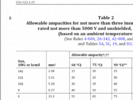I have a 40ft run from panel to garage. My electrician says 6/3 wire and a 60A breaker is good enough for the wall charger (48A max draw)
From what I have read, He should be using a 4/3 wire, with a 60A breaker.
The wire would terminate in a sub-panel in the garage.
What is the consensus? 6/3 is good enough for a 60 A breaker?
From what I have read, He should be using a 4/3 wire, with a 60A breaker.
The wire would terminate in a sub-panel in the garage.
What is the consensus? 6/3 is good enough for a 60 A breaker?



